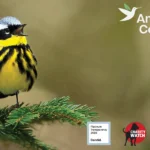Bird photos by Owen Deutsch.
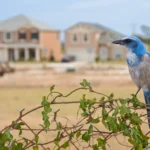
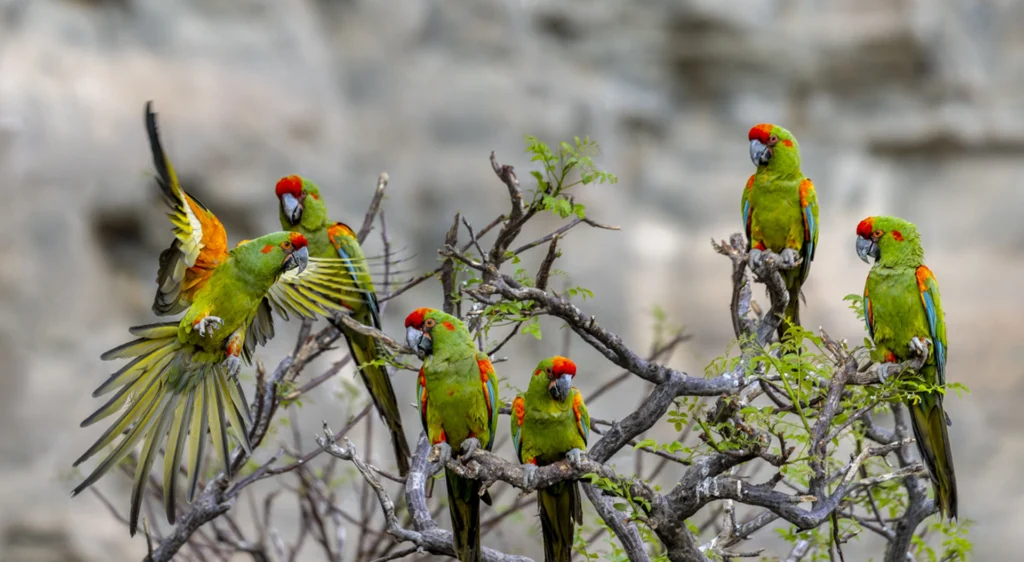
Bird photos by Owen Deutsch.
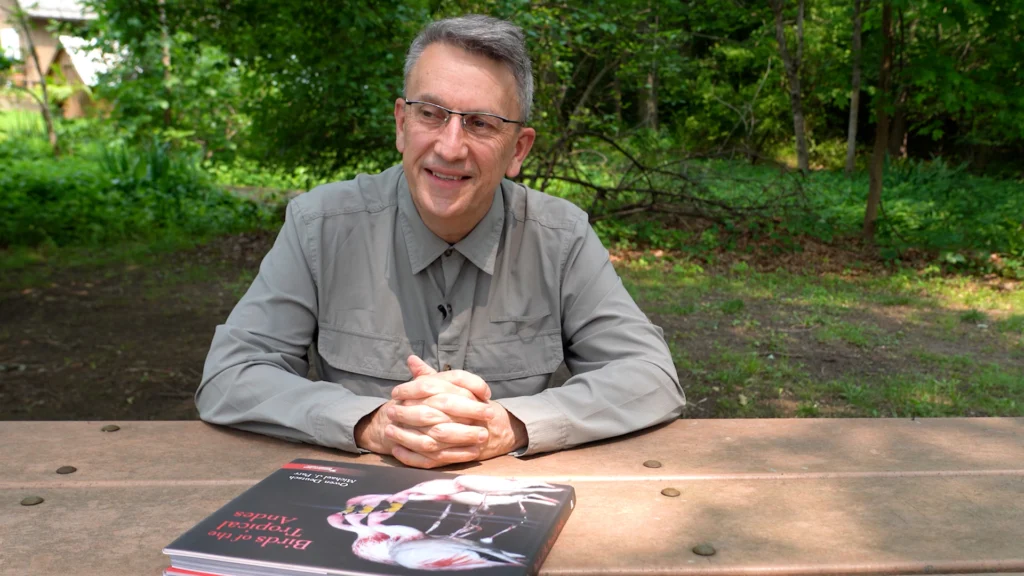
When a pair of Red-fronted Macaws nuzzled each other at a Bolivian sanctuary, one bird gently raising its large foot toward its mate, photographer Owen Deutsch recorded the moment with his camera. The stunning interaction is tempting to anthropomorphize.
Even without assigning human emotions to the scene, however, the photograph still represents a dramatic story. This rare macaw only inhabits part of south-central Bolivia in a desert-like landscape with rocky terrain, and scrubby, thorny vegetation. The species is Critically Endangered due in part to past trapping for the pet trade. Fewer than 800 wild individuals exist, so it’s special to get a glimpse, through Deutsch’s lens, of a pair strengthening their bond in possible preparation for nesting.
The photo is one of a couple of hundred taken by Deutsch that are on display in the new book Birds of the Tropical Andes, published in July by Princeton University Press. Along with the images is in-depth text and detailed photo captions written by Michael J. Parr, ABC’s President. The coffee-table-style book measures nearly 12 x 10 inches and feels hefty in the hand.
Parr and Deutsch previously worked on the 2019 volume Bringing Back the Birds, a similarly sized book featuring photos of species from throughout the Americas, and including essays about bird migration, conservation, and other topics. Birds of the Tropical Andes, as its title implies, focuses on most of western South America and its avian jewels. Spanning more than 4,300 miles, the Andes are the world’s longest continental mountain range and home to some of the planet’s most magnificent birds, from the striking Sword-billed Hummingbird to the fabulous James’s Flamingo.

“The region has the two countries with the most bird species on the planet — Colombia and Peru — and then Ecuador and Bolivia are not far behind,” Parr said. “There are a few reasons why you get such bird diversity. The tropics have a 12-month growing season. It’s wet and humid, so you get year-round plant growth and year-round insects. So you have abundant food for birds and for wildlife that birds feed on, like lizards, snakes, and small mammals.
“Then you add an amazingly diverse topography created by the mountains and valleys running east-west and north-south,” he explained. “Dispersal is limited for specialized species that depend on, for example, one type of flower that only grows at a certain elevation, and when you limit dispersal, you end up with speciation taking place because birds, lizards, and other species become confined to one area or one altitudinal belt. Genetics then concentrate certain traits in these isolated populations, and you get this amazing, vastly biodiverse region.”
No wonder that the tropical Andes are one of the most biodiverse hotspots on the planet and home to more than 1,700 bird species — a third of which are found nowhere else on Earth.
Parr has been a birder since age 7 and has worked in bird conservation since 1989. He has birded throughout the Andes for decades and knows the birds of the region — and the challenges they face — in great detail. Deutsch, a former fashion photographer, has been photographing birds since 2002. He has traveled the globe, building an incredible portfolio (and a dedicated social media audience). Shortly after completing Bringing Back the Birds, the two were traveling together in Ecuador when inspiration struck.

“We had the idea for the book when we were on one of our many long drives in Ecuador on our way to a birding location to get some photographs,” Parr recalled. “And we realized we’ve got a lot of good pictures, so maybe it was time to do a book on the birds of this region.”
After the spark, the pair assembled a small team and planned a series of photographic and research expeditions to the region: one to Ecuador and two each to Peru and Bolivia.
“One of the main highlights for me was the work we did in the high Andes, in the Altiplano, particularly in Bolivia,” Parr said. “One of the places we visited was Laguna Hedionda, in the high plains of Bolivia. Itʼs an area of salt flats and small lakes, with altitudes around 13,500 feet. And itʼs a fairly barren landscape, but itʼs got really amazing birds. Definitely the highlight there is the flamingos, which nest on the high-altitude lakes in that area.”
Incredibly, three of the world’s six flamingo species — James’s, Andean, and Chilean — all breed in the area. “It’s a spectacular, otherworldly environment,” Parr added. “I strongly recommend it as a great place to go and not only to see, but to photograph these flamingos up close.”
Deutsch said no matter where he and Parr visited, he felt like he “was a kid in a candy store. Everywhere we looked, the birds were just incredible — so colorful — and we were just giddy the whole time.”
His hope for the book is that readers “fall in love with the region and with these gorgeous creatures. Because they have to be saved for my grandchildren, for everybody.”
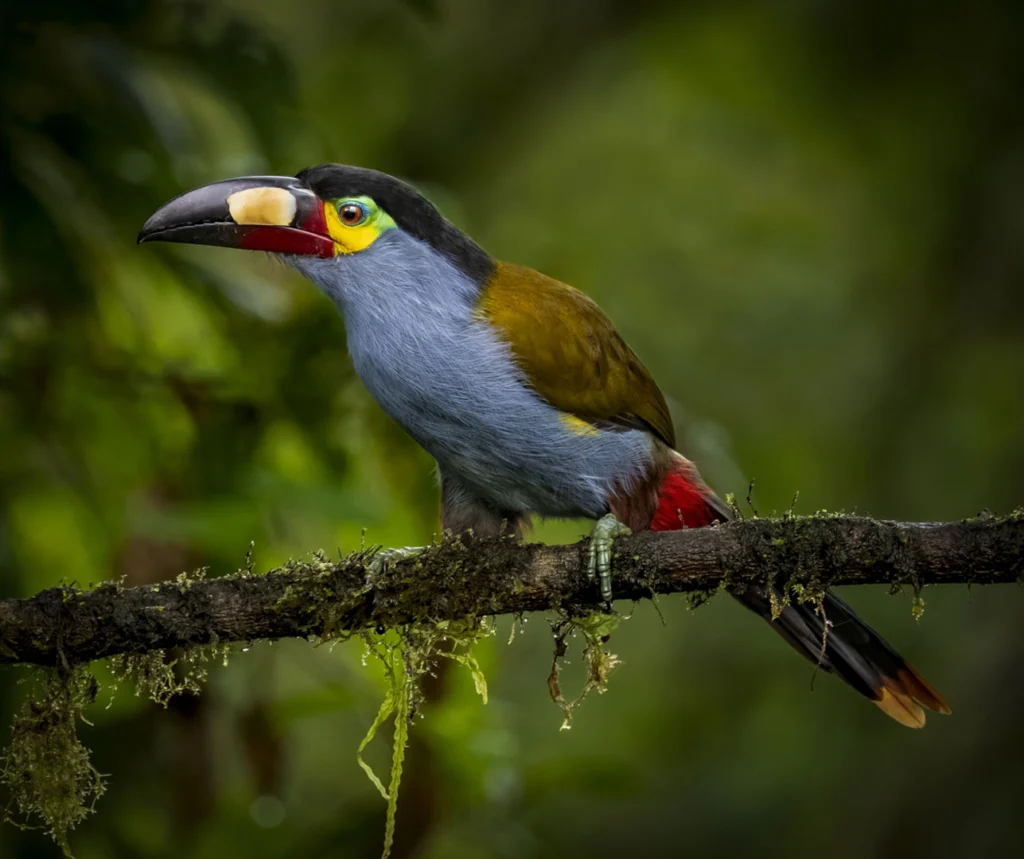
The authors and their two main collaborators — birders Nathan Goldberg and Juan Carlos Crespo — organized their expeditions around finding target species, flamingos, macaws, hummingbirds, and other showstoppers, at certain times. And like any birding trip, they encountered many more species along the way.
“Thereʼs always a supporting cast,” Parr said, “and you never know what it’s going to be. You have an idea, but you never really know if youʼre going to find a Common Potoo or youʼre not (for example). Itʼs a fairly common bird, but actually finding one is hard. And with some of the skulking birds like Ocellated Tapaculo, you’re wondering if they’ll reveal themselves. Thereʼs always something that scoots away, and then thereʼs always something that is a nice surprise.”
The team also wound up in some not-so-nice surprises a couple times. At one stop, a member of the group had a medical issue, “and we had to evacuate and regroup, and then change the whole schedule.” In the end everyone was fine, but it meant that the itinerary had to shift, and quickly.
Another sticky situation happened in the Peruvian Amazon, at a site where macaws gathered at a clay lick that the team had accessed by boat. “We were waiting at the clay lick at dawn for the parrots to show up, and of course, they didn’t show up,” Parr recalled. “Eventually they showed up at midday, which we completely didnʼt expect. Then right after that, it started raining, and the rain became absolutely torrential and went on for about 12 or 14 hours. So by the time we left, the river, which had been fairly calm as we came in, had turned into a monstrous torrent. Whole trees that had been uprooted were going down the river, and we had to navigate this giant whitewater river in a smallish boat. So that was a little hair-raising, but we got out of there alive!”
“Habitat loss by far is the biggest threat to the region’s biodiversity, but by visiting the Andes and the reserves ABC set up with local partners, you can really do a lot to help bird conservation and local communities,” said Michael J. Parr.
Parr wrote the bulk of the book’s text, and he asked a few others to contribute as well. Birding tour leader and author Álvaro Jaramillo penned the foreword, and four ABC partners from the Andes — Rodrigo W. Soria Auza, Constantino Aucca Chutas, Sara Inés Lara, and Martin Schaefer — added personal essays as well.
The essay writers each represent organizations with which ABC has helped to establish bird reserves in the tropical Andes that are critical to conserving rare birds like the Red-fronted Macaw and Marvelous Spatuletail. “Habitat loss by far is the biggest threat to the region’s biodiversity, but by visiting the Andes and the reserves ABC set up with local partners, you can really do a lot to help bird conservation and local communities,” Parr said. In total, ABC and partners have protected over 1 million acres in bird reserves across the Americas, providing habitat for over 3,000 bird species.
Parr noted that Birds of the Tropical Andes is “a book that we created from the ground up based on our field experience in areas where ABC and its partners work.”

“Itʼs designed to encourage people to go to the tropical Andes, to go birding, to enjoy birds and bird photography, and to support conservation. If you visit our partners’ reserves and stay at the lodges, you will already be contributing to help protect these birds.”
The book’s format also called for technical expertise and an artistic eye, and Parr praised Deutsch’s skills on both fronts. “Owen did the bulk of the work on the photography,” he said. “Not just taking the pictures but organizing the pictures. A huge amount of detail goes into that.”
Parr has taken photos of birds for many years, including on his trips with Deutsch. But he noted the differences in their work. “While I took a picture of the bird, Owen was creating a photograph. Itʼs a different mindset. Heʼs thinking about backgrounds and lighting. Itʼs a different discipline. Iʼm learning, but Owen is still the master of that.”
Parr wrote much of the text with traveling birders in mind based on fieldwork in Bolivia, Colombia, Ecuador, and Peru, including 30 expeditions to the region over more than 20 years. He includes detailed explanations for where to bird in certain areas and which species to seek out. And he shares natural history, cultural history, and conservation information, as well as the latest findings from the field.
Birders visiting the Andes for the first time may be stunned by the diversity of species. Parr’s advice: Soak it in and enjoy!
“I think the hummingbirds in general are one of the biggest highlights because there are so many species (at least 140). They have so many colors and so many different shapes, and they also come very close, often with feeders that are now at many of the lodges. We have some hummingbirds in the U.S., but when you get to the Andes, youʼre just going to be drenched in all the different species and colors. It can be overwhelming at first, but slowly youʼll get used to the species and then start to see some of the rare ones. And itʼs just super fun. I was initially daunted by the overall diversity of Andean birds, but once I realized that I didn’t have to try to identify them all at once, and just started to enjoy them, that’s when the fun began!”
Birds of the Tropical Andes by Owen Deutsch and Michael J. Parr.
Foreword by Álvaro Jaramillo. Contributions by Rodrigo W. Soria Auza, Constantino Aucca Chutas, Sara Inés Lara, and Martin Schaeffer. Hardcover, 2025, 264 pages, 200+ photos, size: 11.75 x 9.75 inches.
Learn more about photographer Owen Deutsch at owendeutsch.com and follow him on Facebook and Instagram.
This article originally appeared in the Summer 2025 issue of Bird Conservation, the Member magazine of American Bird Conservancy. Learn more about the benefits of becoming an ABC Member and join today.
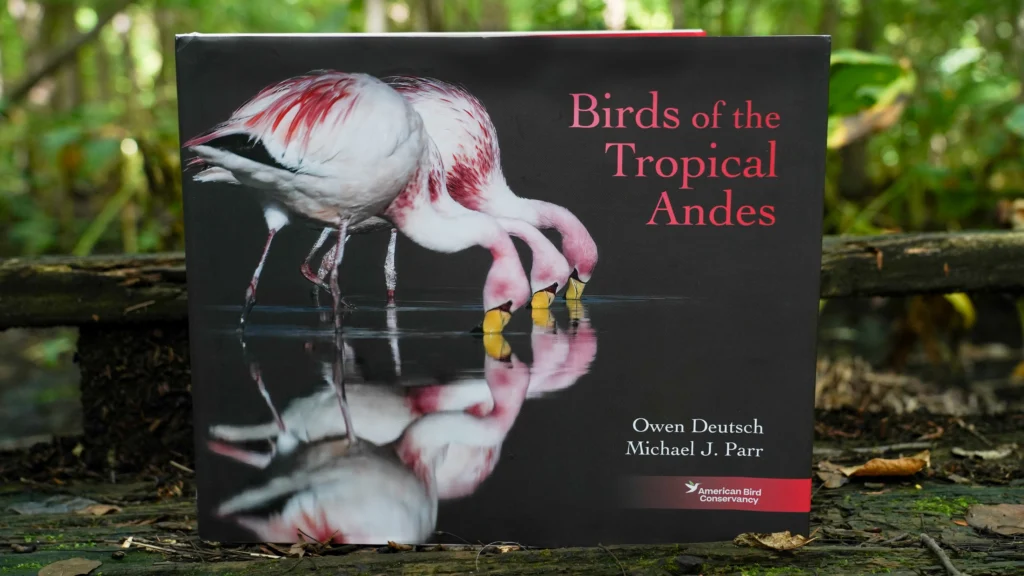
Support ABC with a gift of $50 or a new monthly gift of $10 or more to receive the book!
Get a behind-the-scenes look at the making of Birds of the Tropical Andes with authors Owen Deutsch and Michael J. Parr.

Related News & Stories



